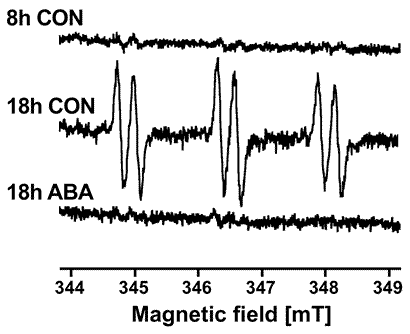Plant Physiology 150: 1855-1865 (2009)
In vivo cell wall loosening by hydroxyl radicals during cress (Lepidium sativum L.) seed germination and elongation growth [W][OA]
The Edingburgh Cell Wall Group, Institute of Molecular Plant Sciences, The University of Edinburgh, The King's Buildings, Mayfield Road, Edinburgh EH9 3JH, United Kingdom (R.A.M.V., S.C.F.)
Commissariat à l'Energie Atomique (CEA), iBiTecS, CNRS URA 2096, Service de Bioénergétique, Biologie Structurale et Mécanisme, 91191 Gif-sur-Yvette Cedex, France (A.K.-L.)
Received April 9, 2009; accepted May 29, 2009; published June 3, 2009
www.plantphysiol.org/cgi/doi/10.1104/pp.109.139204

Supplemental Figure S1 •OH generated in vivo in the apoplast of radicles reacted with the spin trapping system ethanol / POBN to an adduct with a characteristic hyperfine splitting pattern its electron paramagnetic resonance (EPR)-spectrum. This adduct is diagnostic of •OH formation. Representative EPR-spectra for radicles incubated for the indicated times are shown.
| Article in PDF format (1.7 MB) |
|
|
|
The Seed Biology Place |
Webdesign Gerhard Leubner 2000 |